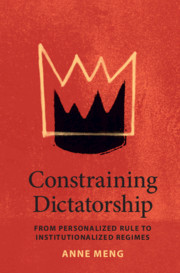Book contents
- Constraining Dictatorship
- Political Economy of Institutions and Decisions
- Constraining Dictatorship
- Copyright page
- Contents
- Figures
- Tables
- Acknowledgments
- Abbreviations
- 1 Introduction
- 2 Why Do Leaders Institutionalize?
- 3 Two Illustrative Cases
- 4 How Should Institutionalization Be Measured?
- 5 What Are the Causes of Regime Institutionalization?
- 6 What Are the Consequences of Institutionalization on Autocratic Stability?
- 7 What Are the Consequences of Institutionalization on Leadership Succession?
- 8 Conclusion
- References
- Index
3 - Two Illustrative Cases
Published online by Cambridge University Press: 18 September 2020
- Constraining Dictatorship
- Political Economy of Institutions and Decisions
- Constraining Dictatorship
- Copyright page
- Contents
- Figures
- Tables
- Acknowledgments
- Abbreviations
- 1 Introduction
- 2 Why Do Leaders Institutionalize?
- 3 Two Illustrative Cases
- 4 How Should Institutionalization Be Measured?
- 5 What Are the Causes of Regime Institutionalization?
- 6 What Are the Consequences of Institutionalization on Autocratic Stability?
- 7 What Are the Consequences of Institutionalization on Leadership Succession?
- 8 Conclusion
- References
- Index
Summary
I illustrate my theoretical argument through two case studies of Cameroon and the Ivory Coast (Côte d'Ivoire). I show that Ahmadou Ahidjo, the first president of Cameroon, came into power weak, therefore institutionalized his regime in order to buy the support of other elites. This was ultimately stabilizing for Cameroon. By comparison, Felix Houphouet Boigny, the first president of the Ivory Coast, came into power strong and did not institutionalize his regime. This was ultimately destabilizing for the Ivory Coast, and the regime fell soon after his death.
- Type
- Chapter
- Information
- Constraining DictatorshipFrom Personalized Rule to Institutionalized Regimes, pp. 64 - 92Publisher: Cambridge University PressPrint publication year: 2020

